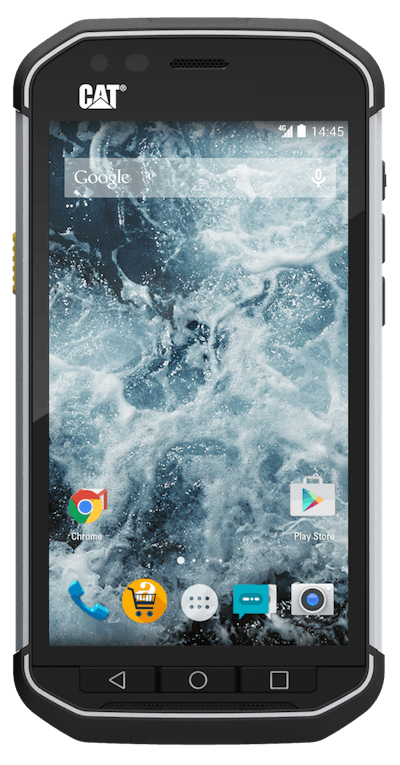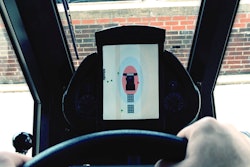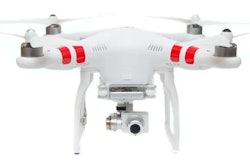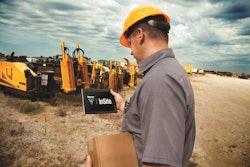
Two years ago, the no. 1 manufacturer of heavy equipment in the world entered a market comprised of concepts and products very different from those it has delivered for nearly 100 years.
In early 2013 the company famous for hulking bulldozers, rugged trucks and other equipment meant for moving mountains of dirt here in the real world, decided to compete with companies like Apple and Samsung, makers of small, sleek, fragile slabs of glass responsible for moving mountains of data in the virtual world.
In partnership with UK tech design firm Bullitt Group, Cat released the B15 with the goal of being the first and only smartphone targeting the desires and demands of the construction industry. In the time since then, Cat has released a spec-bump successor called the B15Q along with a slimmer design called the S50. And just recently the company announced its fourth smartphone, the “refined” S40.
RELATED >> Caterpillar’s Era of Analytics: Coaching customers, autonomous machines and more tech the Iron Giant is planning for the future
The new phone is powered by a fast, quad-core processor coupled with 1GB of RAM and runs the latest version of Android (5.1 Lollipop). It has a 2-megapixel front-facing camera and an 8MP rear camera capable of shooting 1080p video. Like its siblings the B15 and S50, the S40 is drop, water- and dust proof to military specifications. Plus the screen can be used while wearing work gloves and when the screen is wet.
No U.S pricing has been set, though the phone will cost €439 in Europe. The expected U.S. release date is late September or early October.
In the lead up to the S40’s release, we sat down with Bullitt Group senior product manager Pete Cunningham to learn more about the new device, what went into its design and just how much the heavy equipment side of Cat’s business impacts the identity of Cat Phones.
Where the puck is going vs. where it should be
 The S40 has the brightest screen of any Cat Phone yet.
The S40 has the brightest screen of any Cat Phone yet.There’s an old quote from hockey legend Wayne Gretzky that says “Skate to where the puck is going, not where it has been.” The quote, passed down to The Great One by his father Walter, was given further weight years later when it used by the late Apple co-founder and former CEO Steve Jobs who selected it as a way to explain how his company had managed to dream up things like the Macintosh, the iPod and iPhone.
And Jobs was only the most prominent of many, many CEOs and companies to adopt the quote over the years. You can’t blame them. It’s a great thing for a group of people who are attempting to create the next big, culture-altering product to aspire to. The philosophy is best explained by a quote from Jobs himself: “A lot of times, people don’t know what they want until you show it to them.”
The thing about Cat’s approach to smartphones, is that it both adheres to and rejects the “puck” philosophy.
A manufacturer of construction equipment investing the time and resources into developing a line of smartphones isn’t exactly an obvious move just two years after a devastating recession. But Cat knows and understands the power its brand has on jobsites around the world, and if anyone was going to tailor the smartphone to the construction industry, Cat felt it had a better shot than anybody at a time when none of its competitors could do such a thing or cared to.
Besides, the smartphone push is really just a single element of Cat’s proactive stance on technology as of late. With its recent investments and acquisitions in support of providing more actionable data to heavy equipment operators and contractors, the smartphones serve to underscore the company’s focus on becoming a multi-faceted solutions provider to the industry.
This is prime skating-to-where-the-puck-is-going strategy.
But the design process for Cat Phones is another story. Rather than focus on things its users don’t know they want, Cunningham says Bullitt designers are much more interested in the things they do know they want.
Though he did not go into specific numbers, Cunningham says the Cat-branded phones have seen a “tremendous” amount of growth in the last 18 months despite having yet to find a spot on store shelves with a U.S. carrier. He attributes the growth to the connection designers have established with users of the phones.
“I think we’ve exceeded what we looked to achieve,” he says of the lineup’s first two years. “What we’ve tried to do within the business is bring a lot more research-based decisions into our planning. It’s important for us to understand what our target users want and then to implment those within the product.”
With the release of the S50 last year, Cat launched its own app store on both it and the B15Q. But why do that when the phone comes with Android’s Google Play Store installed? “We are targeting a very specific segment of the market,” Cunningham explains. “On Google Play, to search for a specific app for the construction industry, you’ve got to sift through a million other apps. Plus, the store allows us to talk to directly to Cat phone users.”
Since the launch of the app store, Cat has released a number of surveys to its smartphone users. Cunningham says the Cat Phone team has been very happy with the response to those surveys adding that it greatly enhanced Bullitt’s ability to conduct research it could put toward the design of the S40.
Striking a balance
 At 12.5 mm, the S40 is Cat’s thinnest phone yet, but doesn’t sacrifice ruggedness.
At 12.5 mm, the S40 is Cat’s thinnest phone yet, but doesn’t sacrifice ruggedness.“In the run-up to S40 we spoke to over 3,000 people, most of them users of Cat Phones while others were surveyed through research out in the field, mostly construction workers and those working in adjacent industries, he says. “We mainly wanted to see what people thought of rugged phones.”
When conducting that research, Bullitt found that the vast majority of construction workers were using iPhones or Samsung Galaxy S phones with rugged cases. “They told us the problem with rugged phones is that they’re big, bulky and not very elegantly designed,” he says. “Many guys told us ‘If I go out in the evening to the bar, or out on a date, I’m not going to be putting this big rugged phone on the bar.’”

One problem: while the S50 was faster and sleeker than the B15/Q, it wasn’t as tough. It maintained its predecessor’s military spec water- and dust-proof credentials, but drop resistance to concrete fell by 33 percent to 1.2 meters. “With the larger display and LTE, there were compromises we had to make in the rugged credentials,” Cunningham explains.
And while Bullitt could have accepted the decrease in fall resistance as a necessary evil in more closely competing with the phones that dominate the market, they instead quickly went back to the drawing board and began work on the S40. “We analyzed the design successes with the S50 and we learned from it,” he says.
While the S40 features a slightly slower processor and a display that isn’t quite as sharp, the new device holds on to many of the S50’s advances in an even thinner body and all without compromising on ruggedness.
Cunningham says the S40’s 4.7-inch display is the brightest the firm has put on a phone. Plus, the S40 features improved audio quality on calls and a larger battery for all-day use on the jobsite. But most vitally, Cunningham says the S40 is the most rugged Cat Phone yet with the ability to survive multiple drops to concrete from 1.8 meters.
A phone with Cat DNA
While many in the trades might first be attracted to the S40 because of that Cat logo on the back, Cunningham says the thrust of Bullitt’s design process from the start has been to create a phone fully worthy of that trusted badge.
To create the look of the S40, a Bullitt designer spent 10 days with Cat’s equipment design team at the company’s Peoria, Illinois, headquarters, “looking at the machines and their designs and paying attention to certain angles on machine grilles and all of that,” Cunningham says. “And that too is a balancing act because you’ve got to bring that back and while Cat is all about sharp corners and hard metal into the mobile space which might be going a bit rounder, softer.”
But Cunningham says Bullitt wants the devices to mirror Caterpillar machines in more than just appearance. The firm’s goal is to build phones that can be leaned on and abused in the field with the same trust placed in Cat’s dependable machines.
And that requires constant refinement.
“The DNA is not just about how a phone looks, it’s kind of what it stands for as well,” he says.












